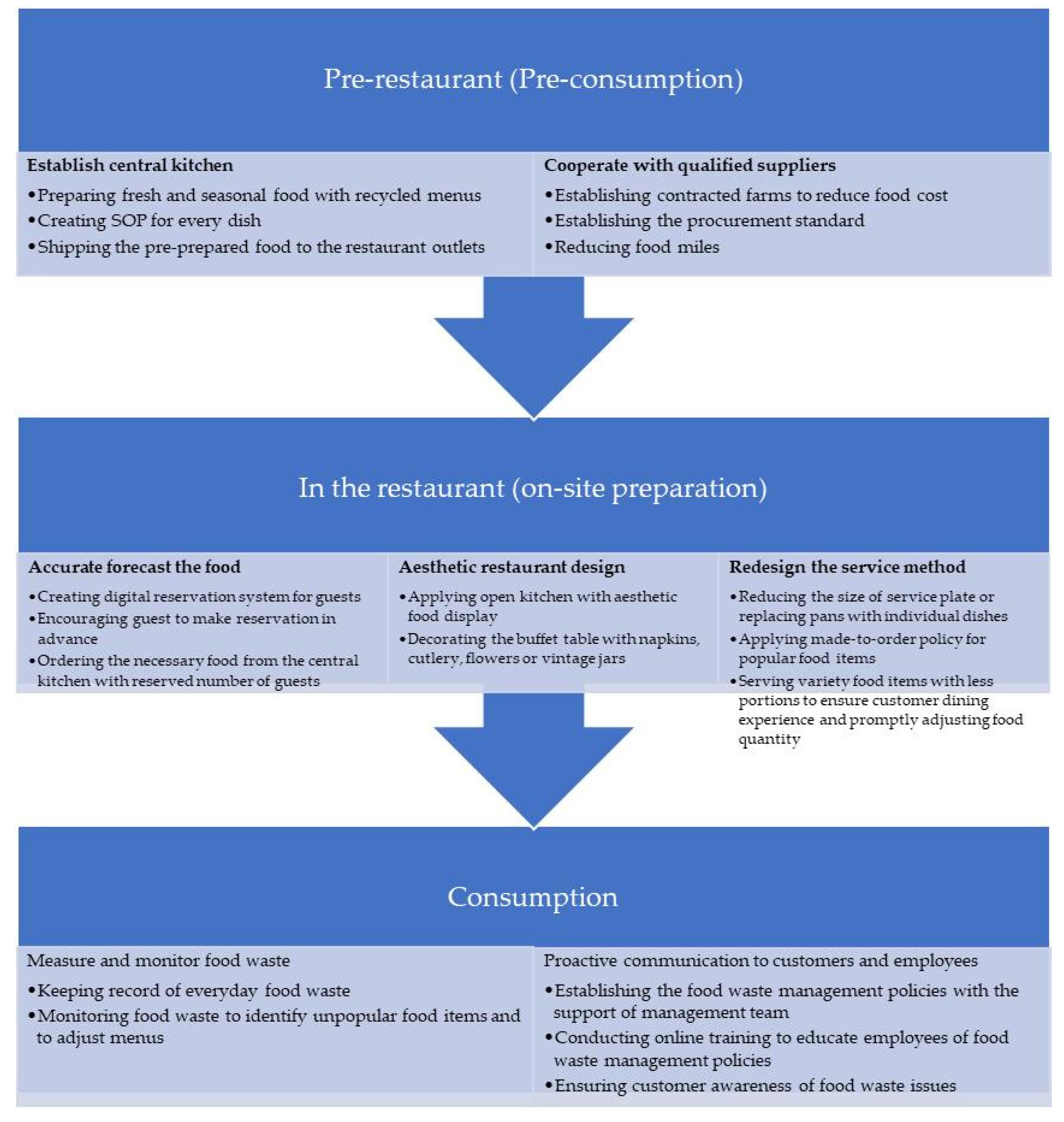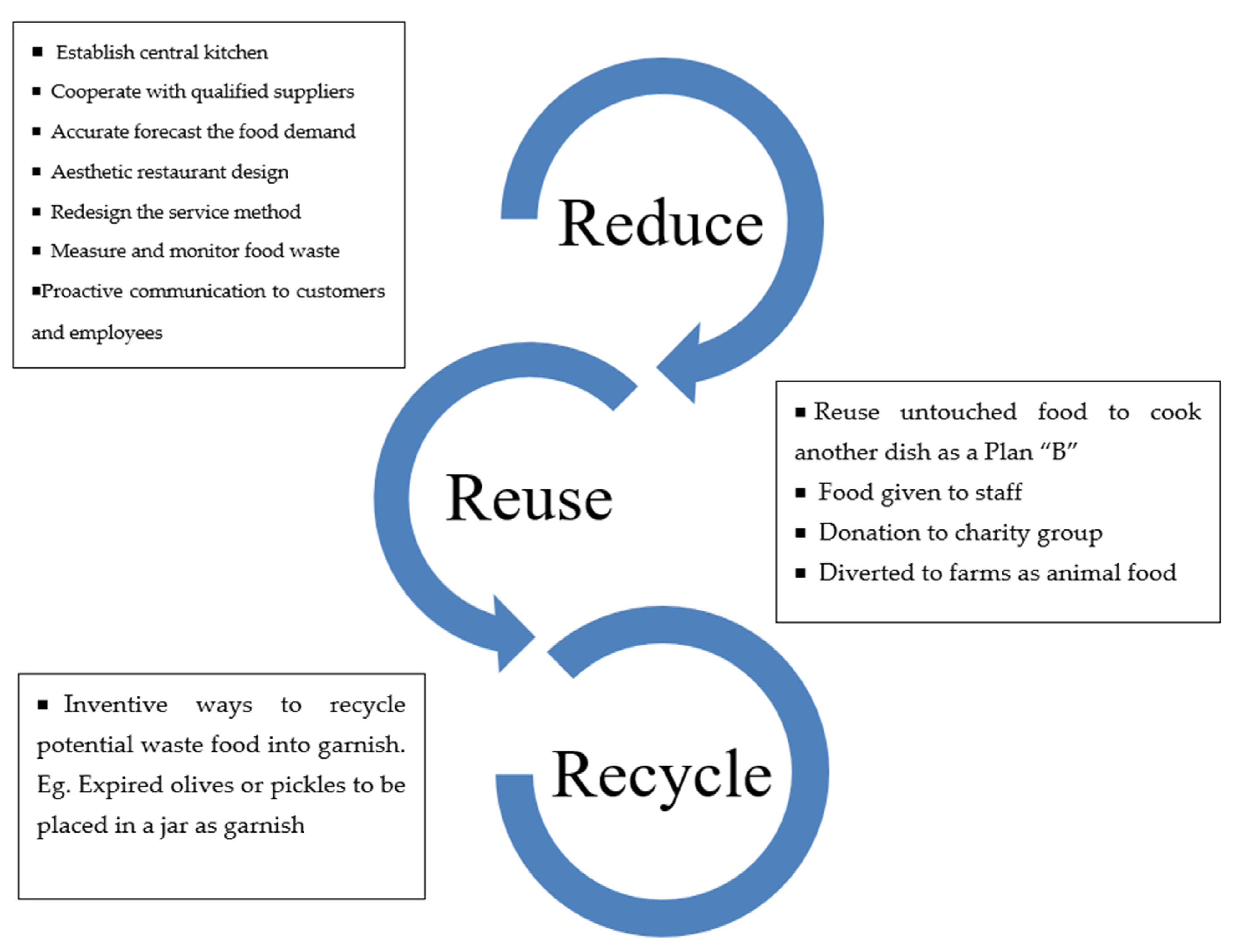Reducing Food Waste in Buffet Restaurants: A Corporate Management Approach
Abstract
1. Introduction
2. Methods
2.1. Participants and Data Collection
2.2. Data Analysis
3. Results and Discussion
3.1. Food Waste per Customer and Causes in Buffet Restaurants
“Most of our food waste is in the stage of preparation food, such as cutting vegetables. However, compared to a regular buffet restaurant, our food waste is much lower, since we do not serve meet products. Meanwhile, most of our guests finish their plates”.(interviewee 6)
“I think the central kitchen taking the order from the restaurant to produce food is a good way to reduce food waste. The more you can prepare at the central kitchen, the less food waste you will generate at the restaurant outlets”.(interviewee 2)
3.2. The Management Approach to the Reduction of Buffet Food Waste
“The central kitchen produces 30 to 35 items per day. We basically wash, cut, marinate, and pre-treat vegetable and meet products, and then ship them to the restaurants. We can deal with the most difficult and time-consuming production. The more we can produce in the central kitchen, the less food waste will yield at the restaurant”.(interviewee 11)
“Most of the food was cooked in the open kitchen with the policy of smaller quantity and more patches in order to control the portion and reduce food waste at the service table”.(interviewee 1)
“We recorded food waste every day in order to accumulate the number for better estimation for the future”.(interviewee 7)
“We will approach customers if they leave a lot of untouched food. We need to know the reasons why they don’t like it. We also provide QR codes to customers for immediate feedback”.(interviewee 6)
“The training courses cover the professional knowledge and competence, food safety and food waste issues. We need to finish 6-chapter courses within a year”.(interviewee 12)
“I found that most of the food waste occurred after dinner. Since company cannot allow employees to bring leftover food home, most of the leftover after dinner will be thrown away. I think it would be nice if we could donate untouched food to food bank or charity groups”.(interviewee 1)
4. Conclusions
5. Limitations and Future Studies
Author Contributions
Funding
Data Availability Statement
Conflicts of Interest
References
- UN Environment Programme. Minimizing Food Waste. Available online: https://www.unenvironment.org/regions/north-america/regional-initiatives/minimizing-food-waste (accessed on 6 January 2020).
- Bruxelles, European Commission. FUSIONS. Estimates of European Food Waste Levels. Available online: http://www.eu-fusions.org/phocadownload/Publications/Estimates%20of%20European%20food%20waste%20levels.pdf (accessed on 8 January 2020).
- Beretta, C.; Stoessel, F.; Baier, U.; Hellweg, S. Quantifying food losses and the potential for reduction in Switzerland. Waste Manag. 2013, 33, 764–773. [Google Scholar] [CrossRef] [PubMed]
- Food and Agriculture Organization of the United Nations. Global Initiative on Food Losses and Waste Reduction. Available online: http://www.fao.org/3/a-i4068e.pdf (accessed on 10 January 2020).
- Pirani, S.I.; Arafat, H.A. Reduction of food waste generation in the hospitality Industry. J. Clean Prod. 2016, 132, 129–145. [Google Scholar] [CrossRef]
- Papargyropoulou, E.; Lozano, R.; Steinberger, J.K.; Wright, N.; bin Ujang, Z. The food waste hierarchy as a framework for the management of food surplus and food waste. J. Clean. Prod. 2014, 76, 106–115. [Google Scholar] [CrossRef]
- Silvennoinen, K.; Heikkilȁ, I.; Katajajuuri, J.M.; Reinikainen, A. Food waste volume and origin: Case studies in the Finnish food service sector. Waste Manag. 2015, 46, 140–145. [Google Scholar] [CrossRef]
- Parfitt, J.; Barthel, M.; Macnaughton, S. Food waste within food supply chains: Quantification and potential for change to 2050. Phil. Trans. R. Soc. Biol. Log. Sci. 2010, 365, 3065–3081. [Google Scholar] [CrossRef] [PubMed]
- Aschemann-Witzel, J.; De Hooge, I.; Amani, P.; Bech-Larsen, T.; Oostindjer, M. Consumer-related food waste: Causes and potential for action. Sustainability 2015, 7, 6457–6477. [Google Scholar] [CrossRef]
- Okazaki, W.K.; Turn, S.Q.; Flachsbart, P.G. Characterization of food waste generators: A Hawaii case study. Waste Manag. 2008, 28, 2483–2494. [Google Scholar] [CrossRef]
- Linder, N.; Lindahl, T.; Borgström, S. Using behavioural insights to promote food waste recycling in urban households—Evidence from a longitudinal field experiment. Front. Psychol. 2018, 9, 352. [Google Scholar] [CrossRef]
- Teng, C.-C.; Chih, C.; Yang, W.-J.; Chien, C.-H. Determinants and Prevention Strategies for Household Food Waste: An Exploratory Study in Taiwan. Foods 2021, 10, 2331. [Google Scholar] [CrossRef]
- Filimonau, V.; De Coteau, D.A. Food waste management in hospitality operations: A critical review. Tour. Manag. 2019, 71, 234–245. [Google Scholar] [CrossRef]
- Christ, K.L.; Burritt, R. Material flow cost accounting for food waste in the restaurant industry. Br. Food J. 2017, 119, 600–612. [Google Scholar] [CrossRef]
- Charlebois, S.; Creedy, A.; Massow, M.V. Back of house—Focused study on food waste in fine dining: The case of delish restaurants. Int. J. Cult. Tour. Hosp. Res. 2015, 9, 278–291. [Google Scholar] [CrossRef]
- Kuo, C.F.; Shih, Y. Gender differences in the effects of education and coercion on reducing buffet plate waste. J. Foodserv. Bus. Res. 2016, 19, 223–235. [Google Scholar] [CrossRef]
- Papargyropoulou, E.; Wright, J.; Lozano, R.; Steinberger, K.; Padfield, R.; Ujang, N. Conceptual framework for the study of food waste generation and prevention in the hospitality sector. Waste Manag. 2016, 49, 326–336. [Google Scholar] [CrossRef]
- Juvan, E.; Grün, B.; Dolnicar, S. Biting off more than they can chew: Food waste at hotel breakfast buffets. J. Travel Res. 2018, 57, 232–242. [Google Scholar] [CrossRef]
- Freeman, M.R.; Brochado, C. Reducing portion size reduces food intake and plate waste. Obesity 2010, 18, 1864–1866. [Google Scholar] [CrossRef]
- Okumus, B.; Taheri, B.; Giritlioglu, I.; Gannon, M.J. Tackling food waste in all-inclusive resort hotels. Int. J. Hosp. Manag. 2020, 88, 10543. [Google Scholar] [CrossRef]
- Okumus, B. How do hotels manage food waste? Evidence from hotels in Orlando, Florida. J. Hosp. Mark. Manag. 2020, 29, 291–309. [Google Scholar] [CrossRef]
- Betz, A.; Buchli, J.J.; Göbel, C.; Müller, C.; Göbel, C.; Müller, C. Food waste in the Swiss food service industry—Magnitude and potential for reduction. Waste Manag. 2015, 35, 218–226. [Google Scholar] [CrossRef]
- Pinto, R.S.; dos Santos Pinto, R.M.; Melo, F.F.S.; Campos, S.S.; Cordovil, C.M.D.S. A simple awareness campaign to promote food waste reduction in a university canteen. Waste Manag. 2018, 76, 28–38. [Google Scholar] [CrossRef]
- Adenso-Díaz, B.; Mena, G. Food industry waste management. Sustain. Food Proc. 2014, 435–462. [Google Scholar]
- Marthinsen, J.; Sundt, P.; Kaysen, O.; Kirkevaag, K. Prevention of Food Waste in Restaurants, Hotels, Canteens and Catering; Nordic Council of Ministers Copenhagen: Copenhagen, Denmark, 2012. [Google Scholar]
- Chang, W.H. Food Waste in Yilan Japanese Restaurant. Master’s Thesis, National Ilan University, Yilan, Taiwan, 2022, unpublished. Available online: https://hdl.handle.net/11296/6au7nu (accessed on 22 September 2022). (In Chinese).
- Kallbekken, S.; Sælen, H. “Nudging” hotel guests to reduce food waste as a win win environmental measure. Econ. Lett. 2013, 119, 325–327. [Google Scholar] [CrossRef]
- Vizzoto, F.; Testa, F.; Iraldo, F. Strategies to reduce food waste in the foodservices sector: A systematic review. Int. J. Hosp. Manag. 2021, 95, 102933. [Google Scholar] [CrossRef]
- Huang, C.H.; Liu, S.M.; Hsu, N.Y. Understanding global food surplus and food waste to tackle economic and environmental sustainability. Sustainability 2020, 12, 2892. [Google Scholar] [CrossRef]
- Chalak, A.; Abou-Daher, C.; Abiad, M.G. Generation of food waste in the hospitality and food retail and wholesale sectors: Lessons from developed economies. Food Secur. 2018, 10, 1279–1290. [Google Scholar] [CrossRef]
- Abiad, M.G.; Meho, L.I. Food loss and food waste research in the Arab world: A systematic review. Food Secur. 2018, 10, 311–322. [Google Scholar] [CrossRef]
- Meet Taiwan. Taiwan Country Overview. Available online: https://www.meettaiwan.com/en_US/menu/M0001341/Country%20Overview.html?function=M0001341 (accessed on 12 July 2021).
- Taiwan Environmental Protection Administration. The Database of Taiwan National Solid Waste. Available online: https://erdb.epa.gov.tw/DataRepository/Statistics/TrashClearNationalProduce.aspx (accessed on 8 January 2020).
- Taiwan Trend Research. Trends and Insights of Foodservice Industry. Available online: https://www.twtrend.com/trend-detail/food-and-beverage-service-activities-2021 (accessed on 10 August 2021). (In Chinese).
- Daily View. Top 20 Luxury Buffet Restaurants in Taipei. Available online: http://gvm.com.tw/article/68867 (accessed on 15 May 2018).
- Creswell, J.W. Research Design: Qualitative, Quantitative and Mixed Methods Approaches, 4th ed.; Sage: Thousand Oaks, CA, USA, 2014. [Google Scholar]
- Braun, V.; Clarke, V. Using thematic analysis in psychology. Qual. Res. Psychol. 2006, 3, 77–101. [Google Scholar] [CrossRef]
- Braun, V.; Clarke, V. Successful Qualitative Research: A Practical Guide for Beginners; Sage: Los Angeles, CA, USA, 2013. [Google Scholar]
- Filimonau, V.; Nghiem, V.N.; Wang, L.E. Food waste management in ethnic food restaurants. Int. J. Hosp. Manag. 2021, 92, 102731. [Google Scholar] [CrossRef]
- WRAP (Waste & Resources Action Programme). Estimates for Household Food and Drink Waste in the UK 2011. Available online: http://www.wrap.org.uk/content/new-estimates-household-food-and-drink-waste-uk (accessed on 6 January 2020).
- Filimonau, V.; Matyakubov, U.; Allonazarov, O.; Ermolaev, V. Food waste and its management in restaurants of a transition economy: An exploratory study of Uzbekistan. Sustain. Prod. Consum. 2022, 29, 25–35. [Google Scholar] [CrossRef]
- Chang, Y.Y.C. All you can eat or all you can waste? Effects of alternate serving styles and inducements on food waste in buffet restaurants. Curr. Issues Tour. 2022, 25, 727–744. [Google Scholar] [CrossRef]
- Kantor, L.S.; Lipton, K.; Manchester, A.; Oliveira, V. Estimating and addressing America’s food losses. Food Rev. 1997, 20, 2–12. [Google Scholar]
- Immanuel, M.; Hartopo, R.; Anantadjaya, S.; Saroso, T. Food waste management: 3R approach in selected family-owned restaurants. J. Manag. Stud. 2013, 2, 18–37. [Google Scholar]
- King, M.F.; Bruner, G.C. Social desirability bias: A neglected aspect of validity testing. Psychol. Mark. 2000, 17, 79–103. [Google Scholar] [CrossRef]


| Code | Gender | Age | Managerial Role | Work Experience in Hospitality Industry | Research Method |
|---|---|---|---|---|---|
| 1 | Male | 35 | Executive chef | 22 | Interview |
| 2 | Male | 49 | Head chef | 17 | Interview |
| 3 | Male | 43 | Head chef | 20 | Interview |
| 4 | Male | 40 | Store manager | 10 | Interview |
| 5 | Male | 34 | Team leader of waitpersons | 14 | Interview |
| 6 | Male | 35 | Executive chef | 14 | Interview |
| 7 | Male | 37 | Head chef | 18 | Interview |
| 8 | Male | 38 | Head chef | 22 | Interview |
| 9 | Female | 33 | Store assistant manager | 8 | Interview |
| 10 | Female | 24 | Team leader of waitpersons | 8 | Interview |
| 11 | Male | 48 | Executive chef | 25 | Focus group |
| 12 | Male | 31 | Food safety manager | 6 | Focus group |
| 13 | Male | 41 | Procurement manager | 23 | Focus group |
| 14 | Male | 42 | Head chef | 20 | Focus group |
| 15 | Female | 62 | Assistant general manager | 9 | Focus group |
Disclaimer/Publisher’s Note: The statements, opinions and data contained in all publications are solely those of the individual author(s) and contributor(s) and not of MDPI and/or the editor(s). MDPI and/or the editor(s) disclaim responsibility for any injury to people or property resulting from any ideas, methods, instructions or products referred to in the content. |
© 2022 by the authors. Licensee MDPI, Basel, Switzerland. This article is an open access article distributed under the terms and conditions of the Creative Commons Attribution (CC BY) license (https://creativecommons.org/licenses/by/4.0/).
Share and Cite
Wu, C.-M.E.; Teng, C.-C. Reducing Food Waste in Buffet Restaurants: A Corporate Management Approach. Foods 2023, 12, 162. https://doi.org/10.3390/foods12010162
Wu C-ME, Teng C-C. Reducing Food Waste in Buffet Restaurants: A Corporate Management Approach. Foods. 2023; 12(1):162. https://doi.org/10.3390/foods12010162
Chicago/Turabian StyleWu, Chi-Mei Emily, and Chih-Ching Teng. 2023. "Reducing Food Waste in Buffet Restaurants: A Corporate Management Approach" Foods 12, no. 1: 162. https://doi.org/10.3390/foods12010162
APA StyleWu, C.-M. E., & Teng, C.-C. (2023). Reducing Food Waste in Buffet Restaurants: A Corporate Management Approach. Foods, 12(1), 162. https://doi.org/10.3390/foods12010162




